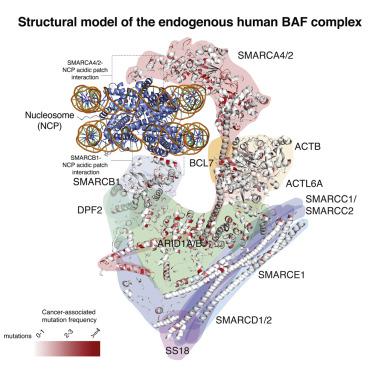Cell ( IF 45.5 ) Pub Date : 2020-10-13 , DOI: 10.1016/j.cell.2020.09.051 Nazar Mashtalir 1 , Hiroshi Suzuki 2 , Daniel P Farrell 3 , Akshay Sankar 1 , Jie Luo 4 , Martin Filipovski 1 , Andrew R D'Avino 1 , Roodolph St Pierre 5 , Alfredo M Valencia 5 , Takashi Onikubo 6 , Robert G Roeder 6 , Yan Han 7 , Yuan He 7 , Jeffrey A Ranish 4 , Frank DiMaio 3 , Thomas Walz 2 , Cigall Kadoch 1

|
Mammalian SWI/SNF complexes are ATP-dependent chromatin remodeling complexes that regulate genomic architecture. Here, we present a structural model of the endogenously purified human canonical BAF complex bound to the nucleosome, generated using cryoelectron microscopy (cryo-EM), cross-linking mass spectrometry, and homology modeling. BAF complexes bilaterally engage the nucleosome H2A/H2B acidic patch regions through the SMARCB1 C-terminal α-helix and the SMARCA4/2 C-terminal SnAc/post-SnAc regions, with disease-associated mutations in either causing attenuated chromatin remodeling activities. Further, we define changes in BAF complex architecture upon nucleosome engagement and compare the structural model of endogenous BAF to those of related SWI/SNF-family complexes. Finally, we assign and experimentally interrogate cancer-associated hot-spot mutations localizing within the endogenous human BAF complex, identifying those that disrupt BAF subunit-subunit and subunit-nucleosome interfaces in the nucleosome-bound conformation. Taken together, this integrative structural approach provides important biophysical foundations for understanding the mechanisms of BAF complex function in normal and disease states.
中文翻译:

内源性人类 BAF 复合物的结构模型告知疾病机制
哺乳动物 SWI/SNF 复合物是 ATP 依赖性染色质重塑复合物,可调节基因组结构。在这里,我们展示了与核小体结合的内源性纯化人典型 BAF 复合物的结构模型,该模型是使用低温电子显微镜 (cryo-EM)、交联质谱法和同源建模生成的。BAF 复合物通过 SMARCB1 C 端 α 螺旋和 SMARCA4/2 C 端 SnAc/post-SnAc 区域双侧参与核小体 H2A/H2B 酸性斑块区域,其中任一区域的疾病相关突变都会导致染色质重塑活动减弱。此外,我们定义了核小体参与后 BAF 复合结构的变化,并将内源性 BAF 的结构模型与相关 SWI/SNF 家族复合物的结构模型进行了比较。最后,我们分配并通过实验询问定位于内源性人类 BAF 复合体中的癌症相关热点突变,识别那些破坏核小体结合构象中 BAF 亚基-亚基和亚基-核小体界面的突变。总之,这种综合结构方法为理解正常和疾病状态下 BAF 复杂功能的机制提供了重要的生物物理学基础。











































 京公网安备 11010802027423号
京公网安备 11010802027423号